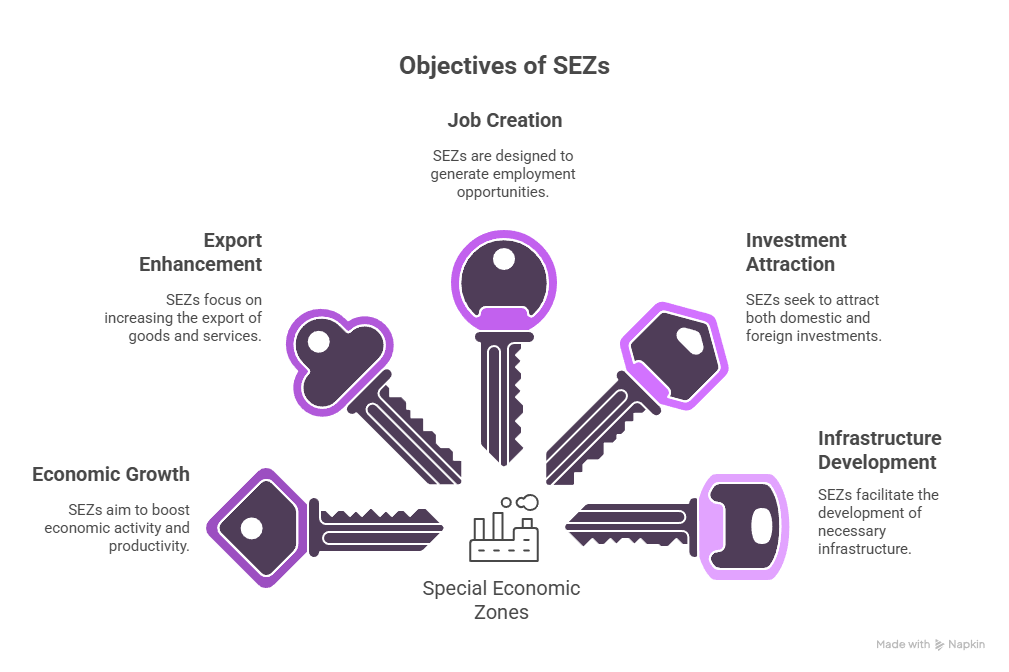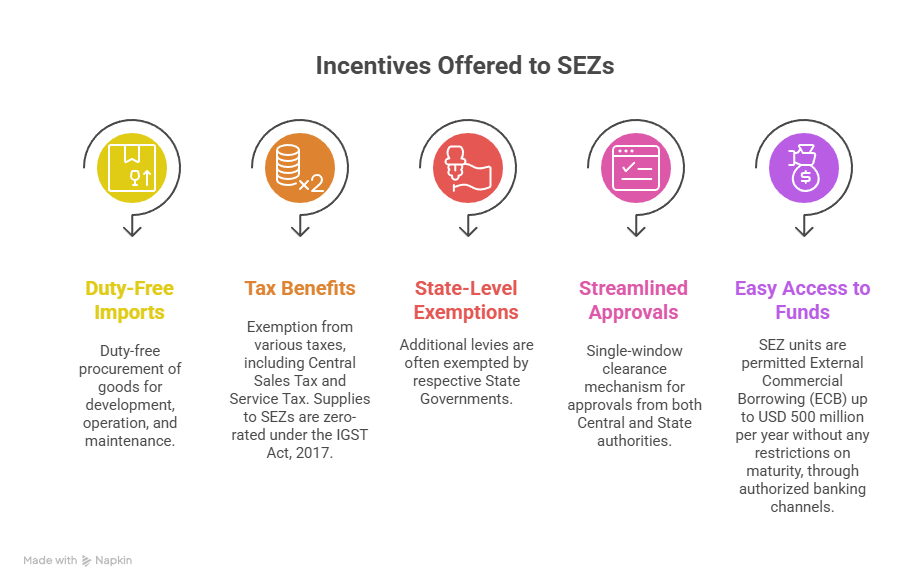Indian Economy
Revitalizing Special Economic Zones (SEZs)
- 06 Nov 2025
- 11 min read
For Prelims: Special Economic Zone (SEZ), Foreign Exchange, Foreign Direct Investment (FDI), Foreign Trade Policy, Delhi-Mumbai Industrial Corridor, Baba Kalyani Committee.
For Mains: key features regarding SEZ, Need for SEZ Reforms in India and steps needed to revitalize India's SEZs.
Why in News?
A government panel, comprising officials from the Commerce and Industry Ministry and NITI Aayog, is currently working on revised norms for Special Economic Zones (SEZs) to help exporters leverage the domestic market, as US tariffs have made exports less competitive.
What is the Need for Revised SEZ Norms in India?
- Countering US Tariffs: High US tariffs have made Indian SEZ exports uncompetitive, reducing export competitiveness.
- Despite these challenges, exporters have attempted to sustain their presence by absorbing losses, highlighting the need for structural reforms.
- Enhance Operational Viability: A key recommendation from exporters is the introduction of a reverse job work policy, allowing SEZ units to serve the domestic market.
- This is expected to optimize labor and equipment use, often underutilized due to seasonal export fluctuations.
- Low Investments: Limited Foreign Direct Investment (FDI) in Indian SEZs restricts technology access, global linkages, and branding due to no investment treaties (unlike Vietnam), poor perception, and weak promotion.
- Low R&D investment, particularly in gems and jewellery, leading to a decline in units (~500 to ~360) and reduced export contribution.
- Globally Uncompetitive: Despite early success, India’s SEZs lag behind China’s, facing productivity issues and the exit of gems and jewellery units due to policy uncertainty and superior incentives abroad.
- With the Net Foreign Exchange (NFE) criterion removed, experts call for a comprehensive trade performance review.
What are Special Economic Zones (SEZ)?
- About: A SEZ is a geographically delineated duty-free area deemed to be foreign territory for the operations of trade, duties, and tariffs.
- They can be established by the private, public, or joint sectors, as well as State Government agencies, to boost economic activity through a conducive and competitive business environment.
- As of 2023–24, 276 SEZs are operational in India, recording exports worth USD 163.69 billion.
- Objectives of SEZs:
- Legal Backing: Introduced in 2000 under the Foreign Trade Policy, replacing Export Processing Zones (EPZs), SEZs are governed by the SEZ Act, 2005 and SEZ Rules, 2006.
- The Special Economic Zone (SEZ) Amendment Bill, 2024 seeks to replace the SEZ Act, 2005 and create flexible Development Hubs that promote exports and domestic investment as integrated trade centers.
- Types of SEZs: The SEZ framework includes various types such as Export Processing Zones (EPZs), Free Trade Zones (FTZs), Industrial Estates, and Free Ports, with examples like GIFT City (India’s first operational smart SEZ).
- Incentives Offered to SEZs:
What Reforms are Needed to Revitalize India's Special Economic Zones?
- Allow Reverse Job Work: Allow SEZ units to undertake manufacturing for domestic firms and sell finished goods in the DTA with a transparent mechanism to neutralize the duty advantage enjoyed by SEZs on inputs used for domestic sales.
- Develop Zone-Specific Industrial Corridors: Develop SEZs as nodes along industrial corridors (e.g., Delhi-Mumbai Industrial Corridor) to enhance connectivity and reduce operational costs. Encourage residential infrastructure near SEZs to attract skilled talent in remote locations.
- Regulatory Reforms: Enact Special Economic Zone (SEZ) Amendment Bill, 2024, simplify exit policies, and implement Baba Kalyani Committee (2018) recommendations, renaming SEZs as Employment & Economic Enclaves (3Es) with separate manufacturing and services rules.
- Global Economic Convergence: Strengthen export infrastructure with customs hubs, e-commerce zones, and fast-track approvals, and pursue mutual recognition agreements (MRAs) for standards and inspections with SEZs in countries like UAE, Singapore, and Europe.
- India can boost SEZ competitiveness by adopting China’s mega-cluster model (Shenzhen) and UAE’s tax-free zones with 100% foreign ownership (Dubai).
- Dispute Resolution Mechanism: Set up commercial courts and international arbitration centers in SEZs to ensure swift, reliable dispute resolution and boost investor confidence.
Baba Kalyani Committee (2018)
- In June 2018, the Ministry of Commerce and Industry formed a committee chaired by Baba Kalyani to review India’s SEZ policy and recommend strategic reforms.
- Key Recommendations:
- Reform SEZ focus: Rename as 3Es (Employment & Economic Enclaves), target domestic demand, and delink from NFE performance.
- Incentive restructuring: Base incentives on investment, job creation, women employment, value addition, and technology differentiation.
- Sector-specific frameworks: Create separate rules for manufacturing and services SEZs.
- Infrastructure & EoDB: Develop high-quality infrastructure and walk-to-work zones, with a single online portal for investment, operations, and exits.
Conclusion
Reforming India’s SEZs is vital to enhance export competitiveness, attract FDI, and boost domestic manufacturing. Key measures include reverse job work, regulatory overhaul via DESH, zone-specific industrial corridors, and strengthened infrastructure and dispute resolution. These reforms aim to transform SEZs into globally competitive, innovation-driven, and employment-generating economic hubs.
|
Drishti Mains Question Discuss the challenges faced by India’s Special Economic Zones (SEZs) in maintaining export competitiveness amid global trade disruptions. |
Frequently Asked Questions (FAQs)
1. What are Special Economic Zones (SEZs)?
SEZs are designated duty-free areas for trade, manufacturing, and services, aimed at boosting exports, FDI, and industrial growth under the SEZ Act, 2005.
2. What is ‘Reverse Job Work’ in SEZs?
It allows SEZ units to manufacture for the Domestic Tariff Area (DTA), ensuring optimal capacity use, profitability, and job security, while maintaining duty parity with domestic industries.
3. What is the primary objective of the proposed DESH Bill, 2022?
The DESH Bill aims to replace the SEZ Act, 2005, to create more flexible 'Development Hubs' that integrate export promotion with domestic manufacturing and investment.
UPSC Civil Services Examination Previous Year Question (PYQ)
Prelims
Q. Consider the following statements: (2009)
- The first telegraph line in India was laid between Kolkata (formerly Calcutta) and Diamond Harbour.
- The first Export Processing Zone in India was set up in Kandla.
Which of the statements given above is/are correct?
(a) 1 only
(b) 2 only
(c) Both 1 and 2
(d) Neither 1 nor 2
Ans: (c)
Mains
Q. There is a clear acknowledgement that Special Economic Zones (SEZs) are a tool of industrial development, manufacturing and exports. Recognizing this potential, the whole instrumentality of SEZs requires augmentation. Discuss the issue plaguing the success of SEZs with respect to taxation, governing laws and administration. (2015)








